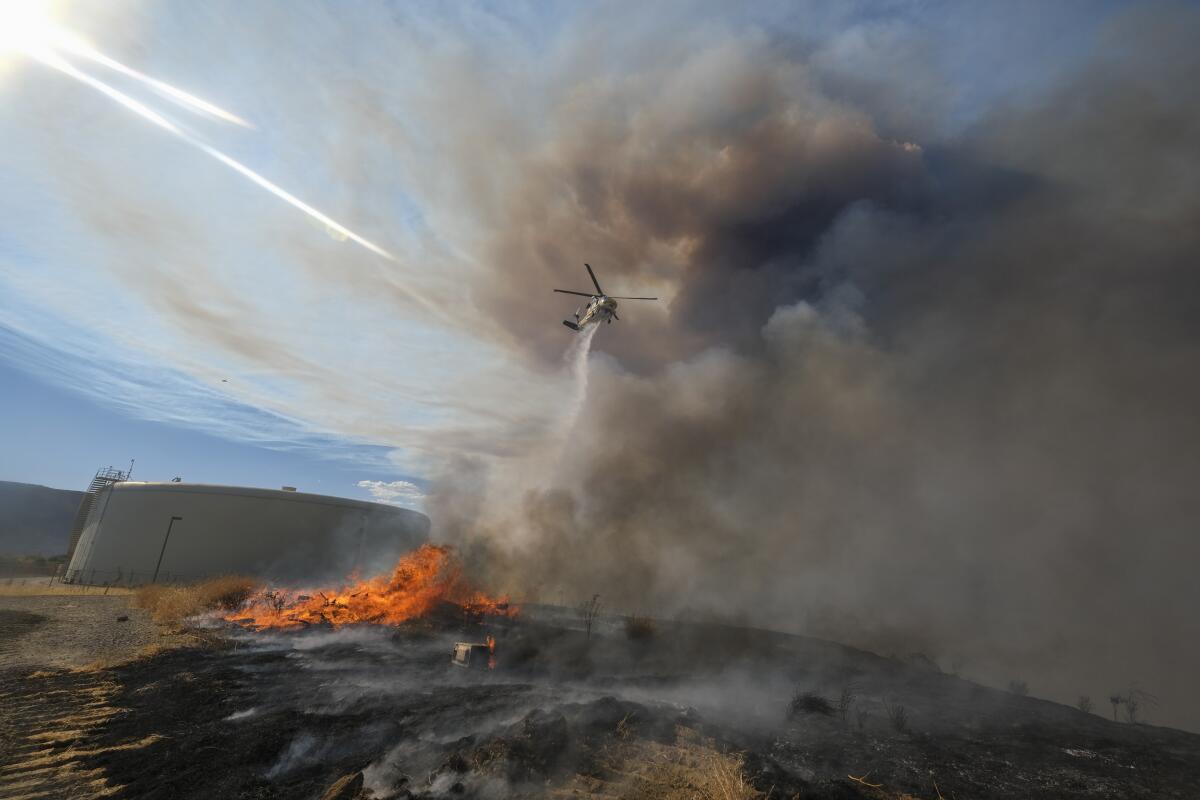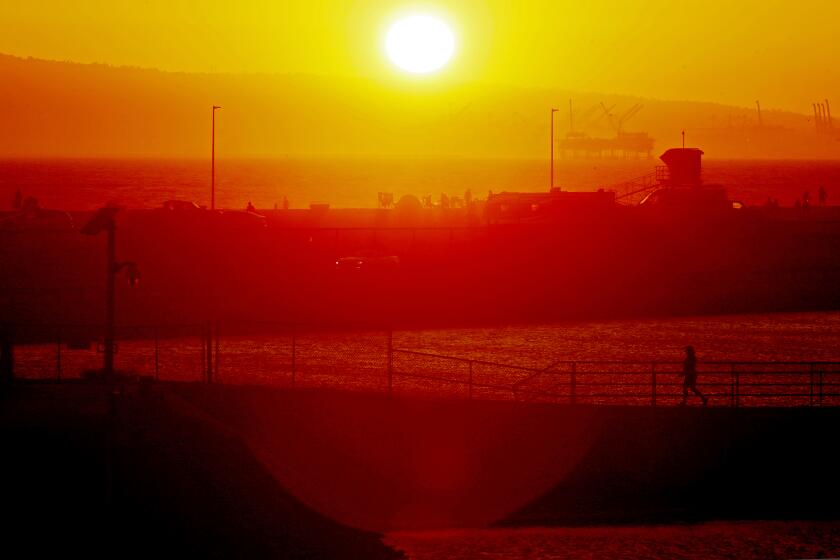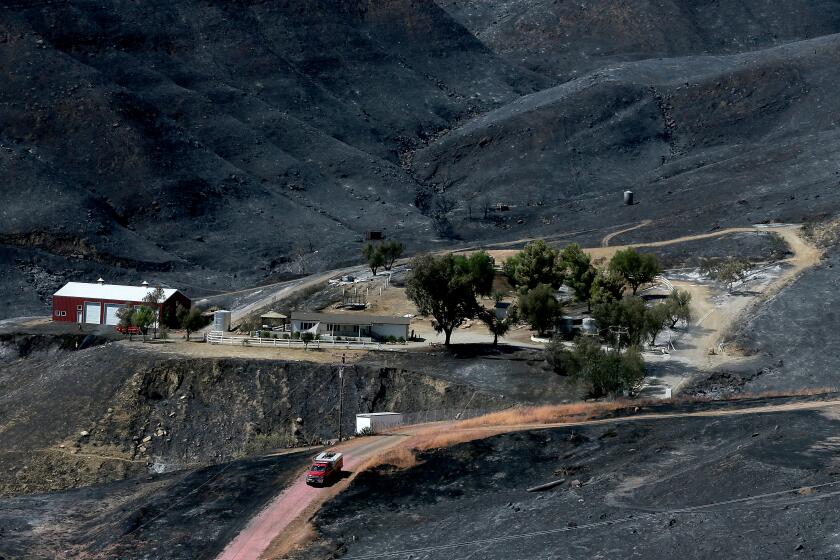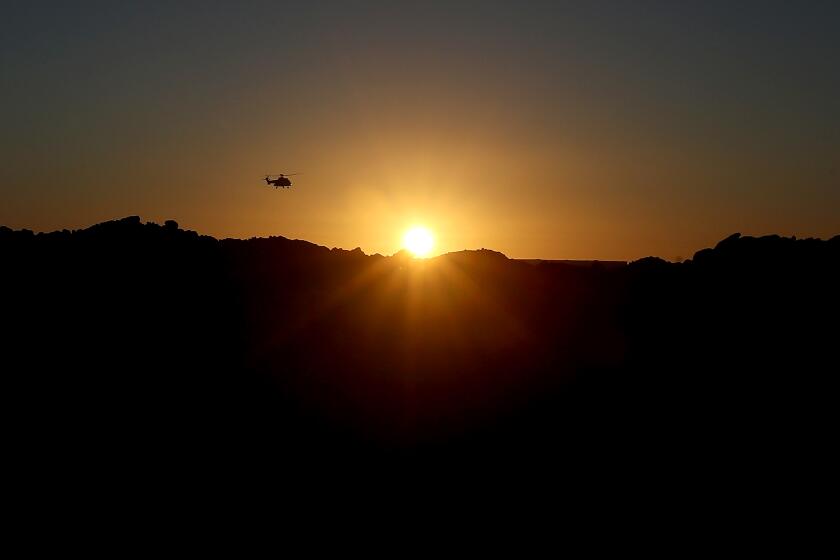Record temperatures, raging fires, a strained power grid: California heat wave in full effect

- Share via
A monster came to life in the rolling hills of northwestern Los Angeles County, belching smoke and flames amid triple-digit heat that has forced officials to call for voluntary energy conservation across California in hopes of preventing rolling blackouts.
In less than 24 hours, the Route fire charred more than 5,000 acres near Castaic, though it appeared that crews were beginning to turn a corner Thursday.
The blaze, which ignited Wednesday afternoon, was holding at 5,208 acres Thursday night, according to the L.A. County Fire Department. Containment increased from 12% in the morning to 27% around 7:30 p.m.
By 1 p.m., all evacuation orders were lifted and residents were allowed to return to their homes.
Crews also made progress on a second major blaze, the Border 32 fire in San Diego County, which remained at 4,438 acres and was 14% contained Thursday night, according to the California Department of Forestry and Fire Protection.
Near the Route fire, temperatures soared to 111 degrees Thursday, said Tom Fisher, a meteorologist with the National Weather Service in Oxnard, citing data from a Southern California Edison gauge near Castaic Lake.
The heat pummeled fire crews working to contain the blaze.
Officials took the unusual step Thursday of pulling back some of the firefighters on the front lines after seven crew members were taken to hospitals for heat-related illness.
The high-pressure system over most of California is expected to bring record-breaking temperatures, part of a “self-perpetuating” system that is becoming more extreme as climate change worsens.
Fire officials said all of the firefighters had been treated and released as of Thursday morning.
The order to pull back, a fire official said, was to reduce the risk to firefighters tackling the most grueling tasks as temperatures soared. Instead, crews would focus on an aerial assault.
“It’s a tactical pause for the crews that are experiencing the greatest heat impact,” Los Angeles County Deputy Fire Chief Thomas C. Ewald said. “We’re just trying to reduce the strain being placed on line firefighters.”
As of Thursday night, the Route fire had destroyed two structures and was threatening 550 more, fire officials said.
The heat wave is expected to last into next week, perhaps as late as Wednesday, bringing high temperatures to both inland and coastal areas and heightening fire dangers.
“It should be a wake-up call to us all,” said U.S. Forest Service Fire Chief Robert Garcia. “The days ahead are going to be very challenging.”
It’s rare for fire officials to pull back resources, especially when high temperatures increase the threat of fires, but Ewald said that “the No. 1 threat right now is to our firefighters. We want to back off the intensity a little bit.”
“For our folks that are out there, they don’t have the opportunity to go into an air-conditioned environment,” Ewald said. “They’re on the line, they’re not in the shade. Their No. 1 tool is hydration and preparation.”
Evacuations have been ordered for Paradise Mobile Home Park as firefighters work to build a containment line.
More than 500 personnel were assigned to the Route fire as of Thursday night, fire officials said. There were 11 hand crews, 58 fire engines, 10 bulldozers, eight helicopters and two fixed-wing aircraft.
But the heat wave and extreme fire conditions across the state also threatened to spread resources thin. Fire officials made sure to launch aircraft early Thursday morning, mindful that they could be diverted to the Border 32 fire, which was threatening homes near the U.S.-Mexico border.
When the state calls for a Flex Alert, you should try to conserve as much power as possible. Here are some ideas for saving energy.
Low humidity, excessive heat and steep terrain also threatened responders’ efforts.
The Route fire was first reported along the 5 Freeway near Lake Hughes Road just after noon Wednesday, leading to full lane closures in both directions.
As of Thursday night, two northbound lanes between Lake Hughes Road and Templin Highway had reopened and two remained closed, according to the California Department of Transportation. On the freeway’s southbound side, three lanes were open and one lane was closed.
The blaze also led to evacuation orders for north of Northlake Hills Elementary School and south of Templin Highway. The orders were lifted by Thursday afternoon, welcomed news for residents fleeing the fire and looking to still escape the scorching heat.
There are 150 L.A. Unified schools in “very high need” of green space and shade, mostly in South and East Los Angeles, where parks are scarce.
Cesar Constantino, 48, and his wife weren’t in their Paradise Ranch Estates mobile home when the fire started Wednesday, but their phones started ringing with calls from neighbors warning them about the approaching flames.
Their three kids grabbed the family’s important documents, their dog, Jokey, and their two Guinea pigs and headed to the Red Cross evacuation center at West Ranch High School for the night.
Constantino and nearly 40 others spent the night in the gym, where they struggled with no air conditioning. On Thursday afternoon, he sat near the front of the gym where residents were to check in, the only place with a working air-conditioning unit.
Instead, the shelter is equipped with four large fans to keep people cool. Some residents opted to sleep in their cars in the parking lot.
On Thursday morning, the property manager warned Constantino electricity and water were still off at the mobile home park.
“We need air conditioning,” he said. “Maybe we’ll get to go back tonight.”
The extreme heat scorching Southern California can be especially dangerous for unhoused people. If you have the means, here are some ways to help.
Capt. Mark McCurdy with Los Angeles County Station 149 and his crew were the first on the scene of the fire Wednesday when they saw it quickly spreading on grass on the northbound side of the 5 Freeway.
Even then, the heat took a toll on the firefighters.
“I’ve done this for a little while now and yesterday was even tough on me,” he said. “A day like yesterday, you still push as hard as you would on a regular day, but it just makes it tougher.”
The punishing heat, meanwhile, continued to bear down on communities around the Southland.
Lancaster, Palmdale and Sandberg set or matched record highs for Sept. 1, with some of the records falling after more than 70 years.
Lancaster saw a high of 112 degrees Thursday, surpassing the previous daily high of 110 set in 1950; Sandberg’s high of 99 broke the 1996 record of 97 degrees; and Palmdale matched its daily record of 109, originally set in 1947.
Meteorologists with the National Weather Service in Oxnard said temperatures could dip by 5 to 10 degrees Friday, but the reprieve will be brief; daily records could be set Sunday in the Los Angeles County valleys, the Antelope Valley and San Luis Obispo County mountains, the weather service said.
It was the second day of record-setting heat in the Los Angeles area.
On Wednesday, Woodland Hills reached 112 degrees, breaking the previous record for the date of 111 degrees set in 1998, according to the National Weather Service.
Burbank’s high of 112 for Wednesday broke the previous daily record of 108 degrees set in 2017, and Sandberg reached 100 degrees that day, exceeding the previous high of 98 degrees, also in 2017, the weather service said.
Faced with increased demand for electricity, the California Independent System Operator, which manages the power grid, extended a Flex Alert into Friday.
During a Flex Alert, consumers are urged to reduce their electricity use from 4 to 9 p.m., when the grid is most stressed because of high demand and less available energy from solar panels.
Flex Alerts were also issued Wednesday and Thursday. The heat wave is expected to extend well into next week.
Authorities are worried about power capacity in part because high temperatures are forecast not just across inland regions that typically broil this time of year, but also along many parts of the coast.
That could mean many more people turning on their air conditioners during peak hours.
Officials are asking Californians to limit electricity use when possible to minimize strain on the state’s energy providers, otherwise risking rolling blackouts. Losing power during such extreme heat can be highly dangerous, if not deadly, especially for the most vulnerable.
More to Read
Sign up for Essential California
The most important California stories and recommendations in your inbox every morning.
You may occasionally receive promotional content from the Los Angeles Times.























